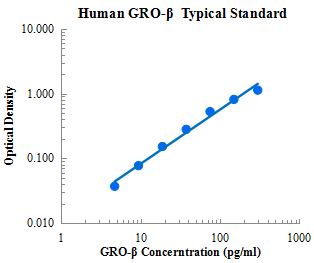
Human GRO-β ELISA Kit
$350.00 – $450.00
| Sample Type | Serum, plasma, cell culture supernatant, and other biological samples |
|---|---|
| Sample Volume | 10 μL |
| Sensitivity | 0.53 pg/mL |
| Range | 4.69 pg/mL – 300 pg/mL |
| Assay Time | 3.5 h |
| Recovery | 85% – 110% |
| Average Recovery | 0.99 |
| Intra Precision | 4.8% – 5.0% |
| Inter-Precision | 3.8% – 4.7% |
| Platform | ELISA |
| Plate | Detachable 96-well plate |
| Size | 96T/48T |
| Storage | If the reagent kit is unopened, it should be stored at 4℃. However, if it has been opened, the standard solution should be stored at -20℃, while the other components should be stored at 4℃. |
| Delivery | 4℃ blue ice transportation |
| Components | 96-well polystyrene enzyme-linked immunosorbent assay (ELISA) plate coated with anti-GRO-β monoclonal antibody Human GRO-β freeze-dried standard GRO-β detect Antibody Standard Diluent Assay Buffer(10×) Substrate TMB Stop Solution Washing Buffer(20×) Sealing Film |
| Assay Principle | This kit utilizes the double antibody sandwich enzyme-linked immunosorbent assay (ELISA) detection technique.Specific anti-human GRO-β antibodies are precoated on a high-affinity ELISA plate. Standard samples, test samples, and biotinylated detection antibodies are added to the wells of the ELISA plate. After incubation, GRO-β present in the samples binds to the solid-phase antibodies and the detection antibodies. After washing to remove unbound substances, streptavidin-HRP labeled with horseradish peroxidase is added. After washing, a colorimetric substrate, TMB, is added and the plate is incubated in the dark for color development. The intensity of the color reaction is directly proportional to the concentration of GRO-β in the samples.A stop solution is added to terminate the reaction, and the absorbance value is measured at a wavelength of 450 nm (with a reference wavelength range of 570-630 nm). |

Targets
CXCL2
CXCL2 Target Infomation Overview
- Target Symbol: CXCL2, C-X-C motif chemokine ligand 2
- Gene Groups: Chemokine ligands
- Alias: SCYB2; GROb; MIP-2a; MGSA-b; CINC-2a
- Previous Names: GRO2
- Alias Names: GRO2 oncogene; chemokine (C-X-C motif) ligand 2
CXCL2, C-X-C motif chemokine ligand 2 Target Infomation by Species
Human CXCL2 Target Information
- Target Symbol: CXCL2, C-X-C motif chemokine ligand 2
- Alias:
- C-X-C motif chemokine 2
- chemokine (C-X-C motif) ligand 2
- CINC-2a
- gro-beta
- GRO2
- GRO2 oncogene
- GROb
- growth-regulated protein beta
- macrophage inflammatory protein 2-alpha
- melanoma growth stimulatory activity beta
- MGSA beta
- MGSA-b
- MIP-2a
- MIP2
- MIP2-alpha
- MIP2A
- SCYB2
- NCBI_Gene: 2920
- UniProtKB: P19875
Human CXCL2 Predicted Functions
Predicted to enable CXCR chemokine receptor binding activity and chemokine activity. Involved in antimicrobial humoral immune response mediated by antimicrobial peptide; killing of cells of other organism; and response to molecule of bacterial origin. Predicted to be located in extracellular region. Predicted to be active in extracellular space. Biomarker of COVID-19 and cystic fibrosis.
Mouse Cxcl2 Target Information
- Target Symbol: Cxcl2, chemokine (C-X-C motif) ligand 2
- Alias:
- CINC-2a
- Gro2
- GROb
- macrophage inflammatory protein 2
- Mgsa-b
- MIP-2
- MIP-2a
- Mip2
- Scyb
- Scyb2
- small inducible cytokine B subfamily
- small inducible cytokine subfamily, member 2
- NCBI_Gene: 20310
Mouse Cxcl2 Predicted Functions
Predicted to enable CXCR chemokine receptor binding activity and chemokine activity. Involved in response to molecule of bacterial origin. Located in extracellular space. Is expressed in several structures, including alimentary system; embryo mesenchyme; floor plate; respiratory system; and skin. Orthologous to several human genes including CXCL3 (C-X-C motif chemokine ligand 3).
Rat Cxcl2 Target Information
- Target Symbol: Cxcl2, C-X-C motif chemokine ligand 2
- Alias:
- C-X-C motif chemokine 2
- chemokine (C-X-C motif) ligand 2
- CINC-3
- cytokine-induced neutrophil chemoattractant 3
- macrophage inflammatory protein 2
- Mip-2
- MIP2
- Scyb2
- small inducible cytokine subfamily member 2
- small inducible cytokine subfamily, member 2
- NCBI_Gene: 114105
- UniProtKB: P30348
Rat Cxcl2 Predicted Functions
Enables chemokine activity. Involved in several processes, including cellular response to interleukin-1; cellular response to lipopolysaccharide; and neutrophil chemotaxis. Located in extracellular space. Biomarker of several diseases, including acute necrotizing pancreatitis; bile duct disease (multiple); brain edema; pleurisy; and pneumonia (multiple). Orthologous to human CXCL2 (C-X-C motif chemokine ligand 2).



